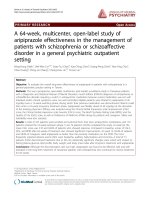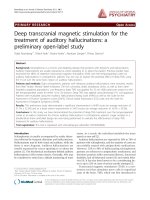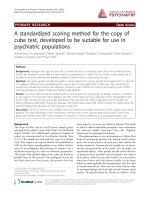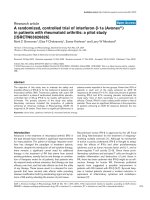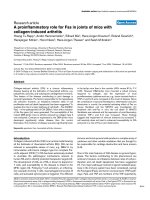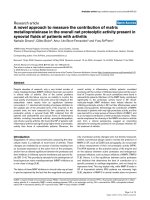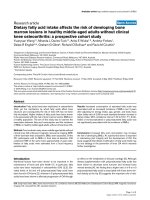Báo cáo y học: " A randomized, controlled clinical trial: The effect of mindfulness-based cognitive therapy on generalized anxiety disorder among Chinese community patients: protocol for a randomized trial" pdf
Bạn đang xem bản rút gọn của tài liệu. Xem và tải ngay bản đầy đủ của tài liệu tại đây (163.37 KB, 19 trang )
This Provisional PDF corresponds to the article as it appeared upon acceptance. Fully formatted
PDF and full text (HTML) versions will be made available soon.
A randomized, controlled clinical trial: The effect of mindfulness-based cognitive
therapy on generalized anxiety disorder among Chinese community patients:
protocol for a randomized trial
BMC Psychiatry 2011, 11:187 doi:10.1186/1471-244X-11-187
Samuel YS Wong ()
Winnie WS Mak ()
Eliza YL Cheung ()
Candy YM Ling ()
Wacy WS Lui ()
Wk Tang ()
Rebecca LP Wong ()
Herman HM Lo ()
Stewart Mercer ()
Helen SW Ma ()
ISSN 1471-244X
Article type Study protocol
Submission date 24 May 2011
Acceptance date 29 November 2011
Publication date 29 November 2011
Article URL />Like all articles in BMC journals, this peer-reviewed article was published immediately upon
acceptance. It can be downloaded, printed and distributed freely for any purposes (see copyright
notice below).
Articles in BMC journals are listed in PubMed and archived at PubMed Central.
For information about publishing your research in BMC journals or any BioMed Central journal, go to
/>BMC Psychiatry
© 2011 Wong et al. ; licensee BioMed Central Ltd.
This is an open access article distributed under the terms of the Creative Commons Attribution License ( />which permits unrestricted use, distribution, and reproduction in any medium, provided the original work is properly cited.
- 1 -
A randomized, controlled clinical trial: The effect of
mindfulness-based cognitive therapy on generalized
anxiety disorder among Chinese community patients:
protocol for a randomized trial
Samuel YS Wong
1§
, Winnie WS Mak
2
, Eliza YL Cheung
1
, Candy YM Ling
3
, Wacy
WS Lui
4
, WK Tang
5
, Rebecca LP Wong
1
, Herman HM Lo
6
, Stewart Mercer
7
, Helen
SW Ma
8
1
Division of Family Medicine and Primary Health Care, School of Public Health and
Primary Care, The Chinese University of Hong Kong, Hong Kong, China
2
Department of Psychology, The Chinese University of Hong Kong, Hong Kong,
China
3
New Life Psychiatric Rehabilitation Association, Hong Kong, China
4
Hospital Authority, Hong Kong, China
5
Department of Psychiatry, The Chinese University of Hong Kong, Hong Kong,
China
6
Department of Social Work and Social Administration, The University of Hong
Kong, Hong Kong, China
7
Section of General Practice and Primary Care, University of Glasgow, Glasgow, UK
8
Centre of Buddhist Studies, The University of Hong Kong, Hong Kong, China
§
Corresponding author
Email addresses:
SYSW:
- 2 -
WWSM:
EYLC:
CYML:
WWSL:
WKT:
RLPW:
HHML:
SM:
HSWM:
- 3 -
Abstract
Background
Research suggests that an eight-week Mindfulness-Based Cognitive Therapy (MBCT)
program may be effective in the treatment of generalized anxiety disorders. Our
objective is to compare the clinical effectiveness of the MBCT program with a
psycho-education programme and usual care in reducing anxiety symptoms in people
suffering from generalized anxiety disorder.
Methods
A three armed randomized, controlled clinical trial including 9-month post-treatment
follow-up is proposed. Participants screened positive using the Structure Clinical
Interview for DSM-IV (SCID) for general anxiety disorder will be recruited from
community-based clinics. 228 participants will be randomly allocated to the MBCT
program plus usual care, psycho-education program plus usual care or the usual care
group. Validated Chinese version of instruments measuring anxiety and worry
symptoms, depression, quality of life and health service utilization will be used. Our
primary end point is the change of anxiety and worry score (Beck Anxiety Inventory
and Penn State Worry Scale) from baseline to the end of intervention. For primary
analyses, treatment outcomes will be assessed by ANCOVA, with change in anxiety
score as the baseline variable, while the baseline anxiety score and other baseline
characteristics that significantly differ between groups will serve as covariates.
- 4 -
Conclusions
This is a first randomized controlled trial that compare the effectiveness of MBCT
with an active control, findings will advance current knowledge in the management of
GAD and the way that group intervention can be delivered and inform future research.
Unique Trail Number (assigned by Centre for Clinical Trails, Clinical Trials registry,
The Chinese University of Hong Kong): CUHK_CCT00267
Background
Generalized anxiety disorder (GAD) is one of the most common mental health
problems seen in the primary care or community setting [1] and is associated with
significant disability and high utilization of health services [2]. According to
established evidence [3], medication or cognitive behavioral therapy are the first line
treatments for its management. However, side – effects and costs associated with
medications can be barriers to treatments and individual cognitive behavioral therapy
can be expensive and time consuming. In addition, for both medication and cognitive
behavioral therapy, persistence of residual symptoms continues to be an issue even for
those who respond to these treatments initially [2]. As a result, there is a need to use
other treatment that falls between a minimalist and intensive approach that can reduce
patients’ symptoms and health care utilization.
One recently established intervention is mindfulness based cognitive therapy based on
mindfulness meditation, modelled after the mindfulness-based stress reduction
(MBSR) programme [4] at the University of Massachusetts. Mindfulness refers to
“paying attention in a particular way on purpose, in the present moment and non-
judgmentally.”[4] For example, a mindful approach to one's inner experience is
simply viewing "thoughts as thoughts" as opposed to evaluating certain thoughts as
positive or negative.
- 5 -
Mindfulness Based Cognitive Therapy (MBCT) (formerly called attentional control)
is a theory driven treatment approach developed by Zindel Segal, Mark Williams and
John Teasdale with the aim to discover a cost-effective treatment approach to
significantly reduce relapse and recurrence of major depression [5]. Cognitive therapy
techniques involved in MBCT include education about mood symptoms, the role of
negative thoughts, and how rumination, avoidance, suppression, and struggling with
unhelpful cognitions and emotions can perpetuate distress rather then resolve it.
MBCT emphasizes acceptance rather than change strategies and offers no training in
changing the content of thinking but rather seeing thoughts as thoughts rather than as
reflections of reality (meta-cognitive awareness) [6]. Recently, MBCT has been
suggested as a therapy for treating anxiety symptoms [7] since training in present
moment mindful awareness may provide a useful way of responding for individuals
with generalized anxiety.
Although it has been shown in randomized controlled clinical trials that MBCT can
reduce the likelihood of relapse in people with recurrent episodes of depression [8,9],
the evidence for the effectiveness of MBCT in reducing anxiety symptoms among
people with anxiety disorder is less well established. So far, three pilot studies, one
that employed mixed methodology and studies with a pre and post intervention design
have been conducted.
In an exploratory mixed qualitative and quantitative study, Finucane & Mercer [10]
showed that the use of mindfulness based cognitive therapy for patients with active
anxiety symptoms in primary care was both acceptable and beneficial to majority of
patients in his study and more than half of the patients in the study continued to apply
mindfulness techniques 3 months after the course had ended. In a study by Evans et al
[11] that employed a pre and post intervention (without control) design, they showed
- 6 -
that there were significant reductions in anxiety and depressive symptoms post
intervention in patients with generalized anxiety disorders. Recently, Yook et al [12]
showed that there were significant improvements in Pittsburgh Sleep Quality Index,
Penn State Worry Questionnaire, Ruminative Response Scale, Hamilton Anxiety
Rating Scale and Hamilton Depression Rating Scale scores at the end of the 8-week
program when compared to scores at baseline. However, all these studies were pilot
studies with small sample size that ranges from 11-22 participants and with no control
group which makes it hard to draw conclusion on the effectiveness of MBCT in
treating anxiety symptoms.
Research objectives
Primary Objectives
The primary objective of the study is to evaluate the superior effects of MBCT in
reducing anxiety symptoms in patients with generalized anxiety disorder from the
community and primary care at 9 months when compared to Psycho-Education Group
using cognitive behavioural therapy and Usual Care (UG) groups.
Secondary objectives
The secondary objectives of this study are to evaluate the effects of MBCT on:
Patients’ reduction of worry symptoms post intervention at 9 months
Patients’ reduction of depressive symptoms post intervention at 9 months
Patients’ reduction of the use of psychiatric medication post intervention at 9
months
Patients’ increase in quality of life post intervention at 9 months
Patients’ reduction in use of health service post intervention at 9 months
Patients’ reduction in leave of absence from work post intervention at 9 months
- 7 -
Methods and Design
The current study protocol was approved by the Joint Chinese University of Hong
Kong and New Territories East Cluster (CUHK-NTEC) Clinical Research Ethics
Committee (CREC).
This study is a randomized controlled trial with three study arms: the MBCT
programme led by trained MBCT instructors, Psycho-Education Group (PEG) using
CBT principles led by clinical psychologist, and usual care (UC) which will be
offered MBCT at the end of the study for ethical reasons. The MBCT and group PEG
consist of eight 2-hour weekly sessions. Outcome measures of all participants will be
collected at similar time points (baseline, immediately post intervention, and at 3, 6
and 9 months post intervention). The previous studies that evaluated the effectiveness
of MBCT for anxiety did not employed a control group; the inclusion of comparison
groups, a usual care group and PEG, will be important in evaluating the benefits of
MBCT.
Three instructors with at least two-year experience in teaching MBSR or MBCT will
lead the MBCT groups while three clinical psychologists with at least master degree
in clinical psychology will be hired for conducting the PEG.
Participants
Entry criteria for the current proposed study will include all of the followings:
1) being 21-65 years of age; 2) having, at baseline assessment, a DSM-IV TR
principal diagnosis of generalized anxiety disorder on SCID (Structured Clinical
Interview for DSM-IV) [13] and a score of 19 or above using the Chinese version of
the Beck Anxiety Inventory [14]; 3) can understand Cantonese; 4) are willing to
attend either the mindfulness based cognitive therapy program or the group cognitive
behavioural therapy; 5) if patient is on medication for his/her condition, he or she
should be on stable doses of medication for 3 months before starting treatment.
- 8 -
Exclusion criteria will include any one of the followings: 1) illiterate subjects as they
will not be able to complete the homework diary; 2) psychiatric and medical
comorbidities that are potentially life threatening (i.e. psychosis, suicidal ideation,
terminal medical illness) or those expected to severely limit patient participation or
adherence (e.g. psychosis, current substance abuse, dementia, pregnancy); 3) those
who are currently seeing a cognitive behavioural therapist or
psychotherapists/counsellors.
Patients will be recruited from: 1) referral from doctors who work in the General
Outpatient Clinics (GOPC) of the New Territories East Cluster of the Hospital
Authority and who are interested in this study; 2) review of those who have been
referred to be seen by a psychiatrist for anxiety symptoms and who are on the wait list
to be seen for at least 12 months (currently there are more than 500 patients in this
category with a majority stating that their major complaint is anxiety);. 3) a website
set up by the University that provide health-related information which is available to
general public.
All interested subjects will be screened on phone by a trained research assistant to
determine eligibility in accordance to the pre-set inclusion and exclusion criteria.
Those eligible subjects will then be scheduled to have a diagnostic interview with a
family physician; the family physician will further confirm the eligibly with the
Structured Clinical Interview for DSM-IV SCID [13]. Both the family physician and
the research assistant are trained to use the DSM-IV SCID with a psychiatrist. All
eligible participants will be seen by the principal investigator (PI) 1-4 weeks before
the start of the interventions to further explain the study, to confirm eligibility, and
provide informed consent.
- 9 -
A statistician who is not involved in any part of the study independently randomized
participants by using a predetermined random table generated by Microsoft Excel
2002. These numbers will not be decoded until the intervention group is assigned.
The allocation is concealed from the researchers, who carries out the baseline
assessment or recorded the data, and the statistician who carried out the analysis. The
allocation is unknown to the participants until the first appointment.
The research study has been approved by the Joint Chinese University of Hong Kong-
New Territory East Cluster (CUHK-NTEC) Ethics Committee.
Mindfulness Based Cognitive Therapy (MBCT) plus usual care – treatment arm
After an initial individual orientation session, the MBCT program will be delivered by
an instructor who has been trained in mindfulness based cognitive therapy and who
has more than 2 years of training experience in MBCT. One programme of 18
participants will be conducted for 8 weeks with 2 hours group training sessions. The
programme will include daily homework exercises which will include guided (taped)
or unguided awareness exercises directed at increasing moment by moment
nonjudgmental awareness of bodily sensations, thoughts, and feelings together with
exercises designed to integrate application of awareness skills into daily life. Key
themes of MBCT include empowerment of participants and a focus on awareness and
acceptance of experience in the moment. Participants are helped to develop a
“decentred” perspective on thoughts and feelings, in which these are viewed as
passing events in the mind.
Psycho-Education Programme based on cognitive behavioural therapy
principle – active control arm
The Psycho-Education Programme is designed to be comparable to MBCT in level of
structure, therapist’s contact and attention, with participants required to adhere to an
agenda during sessions with homework assignments of similar duration. It will consist
- 10 -
of a series of 8 weekly 2-hour sessions. The sessions are based on White’s book on
Treating Anxiety and Stress [15]. All instructors will be qualified clinical
psychologists with training in cognitive behavioral therapy.
Usual care control (UC)
Usual care refers to primary or community care used by participants. In Hong Kong,
the majority of primary care is provided by the private sector with around 20%
provided by public outpatient clinics. In general, patients who use public outpatient
clinics tend to be older, with chronic conditions and who are from a lower socio-
economic status.
As the consultation time is usually short (usually one doctor sees about 40-45 patients
in one morning), they may be lack of time to deal with patients who present with
emotional problems. As a result, usual care can mean minimal care especially if the
patients are from lower socio-economic status. The use of this control is to test the
effectiveness of MBCT against minimal intervention. All controls will be offered
MBCT after the end of the study for ethical reasons.
Measures at baseline and each follow-up: Subjects’ demographic data including age,
sex, marital status, education status, personal monthly income, religious belief, and all
other outcome measures (described below), use of medication (including
psychotropics), and experience with mindfulness and yoga, together with medical
history including psychiatric history will be collected by a trained interviewer. After
the baseline visit, subjects will be randomized as described above. The fidelity of the
intervention will be ensured and monitored by a random review of audiotapes that are
recorded during all sessions.
- 11 -
Outcome measures:
These will be measured at baseline and at 8 weeks (end of intervention) and will be
repeated at 3 months and 6 months and 9 months after intervention.
Primary outcome measures:
Anxiety symptoms will be measured using the validated Chinese version Penn State
Worry Questionnaire [16] and the Chinese version Beck Anxiety Inventory [17]. The
use of two validated questionnaire is to improve validity of findings. The Penn State
Worry Questionnaire is a measure of worry phenomena and has been demonstrated
valid in cross-cultural populations. In a study that examined the factor structure and
psychometric properties of the Chinese version of PSWQ, this scale has been shown
to have good internal consistency, and both convergent and discriminate validity. [18]
The Beck Anxiety Inventory (BAI) is the measure most frequently used to assess the
construct of anxiety. It is a popular measure due to its efficient, cost-effective and
easy to administer, complete and interpret with good reliability and internal
consistency [17].
Secondary outcome measures:
Depressive symptoms will be measured by the validated Chinese version of the
Centre for Epidemiological Studies-Depression Scale (CES-D) [19]. Health related
quality of life will be measured by the validated Chinese version Medical Outcomes
Study Short-Form Health Survey (SF-12) [20]. The SF-12 is a 12-item survey that
reports health-related quality of life, including both physical and mental functioning
and well-being. It has shown to be a valid measure for measuring health related
quality of life in local Chinese population.
“Mindfulness” will be measured by the Five Facet Mindfulness Questionnaire [21].
Health service utilization and medication use: Utilization of health services including
visits to primary care doctors (both private and public) and hospitalizations and the
- 12 -
number of days of absence from work attributable to anxiety will be recorded at 4
weekly intervals by the trained research assistant using telephone. The frequency and
duration of practice of both MBSR and PEG in each group will be documented by a
Weekly Homework Form that will be collected each week during class and at 3 month
interval until the end of 9 month post intervention. Moreover, medication use
including changes in medication will be monitored at 3 month interval. Response rate
(enrolment of subjects), retention rate (number and proportion attended each class) of
the MBCT and the psycho-education group will be documented.
Data and statistical analysis
Baseline characteristics of the three groups will be compared by ANOVA test for
continuous variables and chi-square test for categorical variables. The baseline factors
will include age, sex, medication status, psychological and lifestyle characteristics.
Our primary end point is the change of anxiety and worry score (BAI and Penn State
Worry Scale) from baseline to the end of intervention. Secondary outcomes included
the change in scores of CES-D and SF-12. For primary analyses, treatment outcomes
will be assessed by ANCOVA, with change in anxiety score as the baseline variable,
while the baseline anxiety score and other baseline characteristics that significantly
difference between groups will serve as covariates. A two-sided P value of 0.05 or
less will be considered be statistically significant. For secondary analyses, the three
groups will be simultaneously taken into the analysis of variance model for repeated
measures. The baseline measurement of anxiety symptoms and any significant
secondary outcome variables will be entered into the model as a covariate as they are
considered to be confounders. Analysis will also be performed on an “intention to
treat” analysis.
- 13 -
Since there have been no studies on MBCT with an active control that control for
contact time and attention, we need to use the only available study on GAD with an
active control by Wetherell et al
[22] for sample size calculation. The null hypothesis
for this study is that there will be no improvement in the outcome measures in the
MBCT group relative to other groups and we will test this hypothesis using a one-
sided analysis.
Assuming that the average change of mean score of BAI of patients in MBCT is 5.6
(7.4), in the discussion group is 2.0 (7.4) and that in usual care control is 1.1(7.4) with
a 1-sided type I error of 5% and 80% power to detect statistical significant differences
between the MBCT and psycho-education group as well as MBCT and usual care
control, the required sample size is 76 subjects in each group. We set our enrolment
target at 228 subjects.
Discussion
This will be the first study conducted to investigate the usefulness of MBCT using a
control group in the treatment of anxiety symptoms in those with generalized anxiety
disorder. One of the key strengths of this proposed study when compared to previous
studies in this field is the use of an active control group since most of the previous
studies have only employed a pre-post design or lack of an active controls.
Since the active control group is conducted by psychologists using CBT principles,
which is the current recommended low intensity intervention by the National Institute
of Clinical Excellence (NICE) for patients with GAD who suffer from milder
symptoms of anxiety in the UK, the results of this trial will advance current
knowledge in the management of GAD and the way that group intervention can be
delivered and inform future research. One of the advantages of MBCT is the potential
- 14 -
for having larger number of participants when compared to normal CBT group (range
from 6-8). In this study, we plan to have larger group size than group size previously
adopted by previous investigators of MBCT trial.
If MBCT is shown to be effective in reducing participants’ symptoms, further
economic analysis can be conducted to further evaluate the cost-effectiveness of this
intervention. Moreover, it can be further disseminated in various primary and
community settings for helping patients with GAD in the community.
Limitations
Participants who volunteer for the study could be biased towards non-
pharmacological treatment and those who are assigned to the usual care group may be
disappointed and drop out from the study. Although we will offer MBCT at the end of
the study, the attrition rate for this group of participants is likely to be higher. Further
analysis of the demo-sociographic characteristics of pateints who enrolled in our
study will further inform the generalizability of our findings.
Competing interests
The authors declare they have no competing interests.
Authors' contributions
SYSW conceived of the study, and participated in its design and coordination, as well
as the drafting of the manuscript. WWSM participated in its design and analysis, as
well as revising the manuscript. EYLC participated in its design, as well as the
revision of the manuscript. She also participated in the conduct of intervention.
CYML participated in the coordination, as well as the revision of the manuscript. She
- 15 -
also participated in the drafting of the protocol for the intervention. WWSL
participated in the coordination, as well as the revision of the manuscript. She also
participated in the conduct of intervention. WKT participated in the study design, as
well as data collection and interpretation of data and revising the manuscript critically
for intellectual content. RLPW participated in the coordination, management of data
collection as well as manuscript revision. HHML participated in the design, as well as
the conduct of the MBCT intervention, as contributed to intellectual content of the
manuscript. SM contributed to the design of the study, as well as interpretation of data
and analysis plan, as well as revision of the manuscript. HSWM contributed to the
design, as well as analysis plan and interpretation of data. She also contributed to the
revision of the manuscript. All authors read and approved the final manuscript.
Acknowledgements
The authors would like to acknowledge the funder of this study. The Health Service
Research Fund of the Food and Health Bureau of the HKSAR government. Final
acknowledgements are due to the study participants, both clinicians who refer
participants to the study and patients.
References
1. Nisenson LG, Pepper CM, Schwenk TL, Coyne JC: The nature and
prevalence of anxiety disorders in primary care. Gen Hosp Psychiatr 1998,
20:21-28
2. Simon G, Ormel J, VonKorff M, Barlow W: Health care costs associated
with depressive and anxiety disorders in primary care. Am J Psychiatry
1995, 152:353-357
- 16 -
3. National Institute of Clinical Evidence: Management of anxiety (panic
disorder, with or without agoraphobia, and generalised anxiety disorder) in
adults in primary, secondary and community care. NICE Clinical Guideline
22, April 2007.
4. Kabat-Zinn J: Full catastrophe living: using the wisdom of your body and
mind to face stress, pain, and illness. New York: Delacourt; 1990.
5. Segal ZV, William JM, Teasdale JD: Mindfulness-based cognitive therapy for
depression. A new approach to preventing relapse. New York: Guilford Press;
2002.
6. Roemer L, Orsillo SM: Expanding our conceptualization of and treatment
of generalized anxiety disorder: intergrating mindfulness/acceptance
based approaches with existing cognitive-behavioral models. Clin Psychol
Sci Prac 2002, 9: 54-68
7. Astin JA: Stress reduction through mindfulness meditation: effects on
psychological symptomatology, sense of control and spiritual experiences.
Psychother Psychosom 1997, 66: 97-106
8. Teasdale JD, Segal ZV, Williams JMG, Ridgeway VA, Soulsby JM, Lau M:
Prevention of relapse/recurrence in major depression by mindfulness-
based cognitive therapy. J Consult Clin Psychol 2000, 68: 615-623
9. Ma SH, Teasdale JD: Mindfulness-based cognitive therapy for depression:
replication and exploration of differential relapse prevention effects. J
Consult Clin Psychol 2004, 72: 31-40
10. Finucane A, Mercer, SW: An exploratory mixed methods study of the
acceptability and effectiveness of mindfulness-based cognitive therapy for
- 17 -
patients with active depression and anxiety in primary care. BMC
Psychiatry 2006, 6: 14
11. Evans S, Ferrando S, Findler M, Stowell C, Smart C, Haglin D: Mindfulness-
based cognitive therapy for generalized anxiety disorder. J Anxiety Disord
2008, 22: 716-721
12. Yook K, Lee SH, Ryu M, Kim KH, Choi TK, Suh SY, Kim YW, Kim B, Kim
MY, Kim MJ: Usefulness of mindfulness-based cognitive therapy for
treating insomnia in patients with anxiety disorder: A pilot study. J Nerv
Ment Dis 2008, 196: 501-503
13. Kam IWK: Development of the bilingual (Chinese/English) SCID-I
(Structured Clinical Interview for DSM-IV Axis I disorder): a study of its
reliability and validity in an in-patient population. Dissertation for Part III
Examination of Fellowship. Hong Kong: Hong Kong College of Psychiatrist;
2000
14. Hyman RT: Improving discussion leadership. New York: Teachers College
Press, 1980
15. White J: Treating Anxiety and Stress: A group Psycho-educational approach
using brief CBT. Chichester: John Wiley & Sons, LTD; 2000
16. Meyer TJ, Miller ML, Metzger RL, Borkovec TD: Development and
validation of the Penn State Worry Questionnaire. Behav Res Ther 1990,
28: 487-495
17. Cheng SKW, Wong CS, Wong KC, Chong GHC, Wong MTP, Chang SSY: A
study of psychometric properties, normative scores, and factor structure
of the Beck Anxiety Inventory – the Chinese version. Chinese J Clin
Psychol 2002, 10: 4-6
- 18 -
18. Zhong J, Wang C, Li J, Liu J: Penn State Worry Questionnaire: structure
and psychometric properties of the Chinese version. J Zhejiang Univ Sci B
2009, 10: 211-218
19. Cheung CK, Bagley C: Validating an American scale in Hong Kong: The
Centre of Epidemiological Studies depression scale (CES-D). J Psychol
1998, 132: 169-186
20. Lam CLK, Tse EYY, Gandek B: Is the standard SF-12 health survey valid
and equivalent for a Chinese population. Qual Life Res 2005, 14: 539-547
21. Baer RA, Smith GT, Hopkins J, Krietemeyer J, Toney L: Using self-report
assessment methods to explore facets of mindfulness. Assessment 2006, 13:
27-45
22. Wetherell JL, Gatz M, Craske MG: Treatment of generalized anxiety
disorder in older adults. J Consult Clin Psychol 2003, 71: 31-40

